
Immersive Virtual Reality (VR) Video System and Its Internet Application
|
With the development of electronic consumption industry, immersive virtual reality (VR) can provide a high definition, more vivid and interactive visual experience, which is becoming more and more popular with consumers, and has a large number of potential market demands. In this project, we study the following key problems: 1) video content generation, high quality video capturing and video stitching technology; 2) high efficiency and low complexity video codec; 3) low complexity and high quality video rendering technology, user interaction; 4) visual perception models to improve user's visual experience. We strive for innovations and breakthroughs in the above aspects, and form the core technologies with intellectual property rights. |
 |
Analyzing, Predicting and Controlling the Complex Network Behaviors with Multi-language Big Data
 |
The social ties and information exchange under the networking environment with multiple languages, forms the complex network system with rich content and huge volume. To study the efficient algorithms for predicting its abnormal behavior, and the theory of interruption, helps understanding and controlling the complex systems. In this project, we study how to organize and manage the data containing information with multiple languages; study the characters and evolution rules of the complex network behavior; study the theory of prediction and interruption of the abnormal behavior, and design efficient algorithms to test the performance of the strategy of interruption. |
Research on The Optimization-Based Coordination for Multiagent Systems
|
Multiagent system is one of the primary research directions in the study of distributed artificial intelligence. In particular, the coordination methods for the multiagent systems have been widely applied in the fields such as information integration, crowd simulation and robot control. In this project, we have designed the mechanism to provide the safe actions for the agents running in the realtime context, base on which a coordinating navigation approach is proposed. The efficiency of the our methods have been demonstrated by the analysis and the simulations. |
 |
Molecular Simulation and Structure Prediction of Proteins
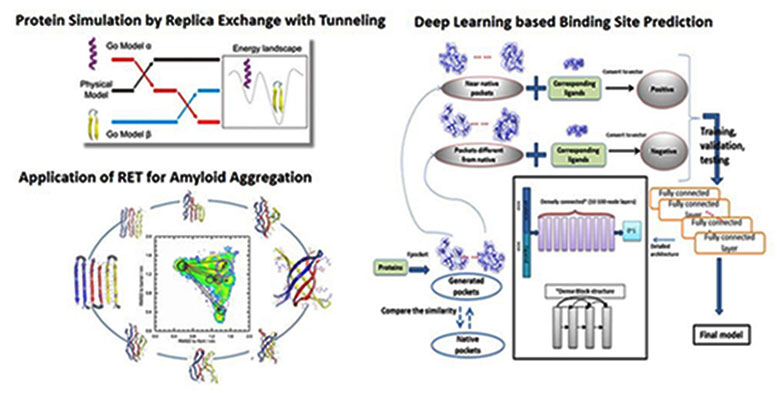 |
The efficient molecular simulation and structure prediction of proteins have great significance on understanding the function and mechanism of biological macromolecules and drug design. Our lab improves advanced enhanced sampling methods to study the mechanism of protein folding and amyloid-aggregation, and develops methods for protein structure prediction and protein-ligand interaction analysis based on mathematical optimization and machine learning. |
Large Scale Genomic Data Analysis
|
Next Generation Sequencing techniques generate vast amount of genetic data that requires highly scalable and efficient tools for analyzing these data. Sequencing reads from the machines can be in the range of TB-PB range, sequential algorithms can no longer meet the needs. We have developed De Bruijn graph based approach for assembling the raw reads. Through mathematical abstraction and building an asynchronous computing model, we have developed SWAP-Assembler for large scale genome assembly. We have demonstrated that SWAP-Assembler can scale to hundreds of thousands cores on Mira@Argonne National Lab. |
 |
Cuff-less Blood Pressure Measurement
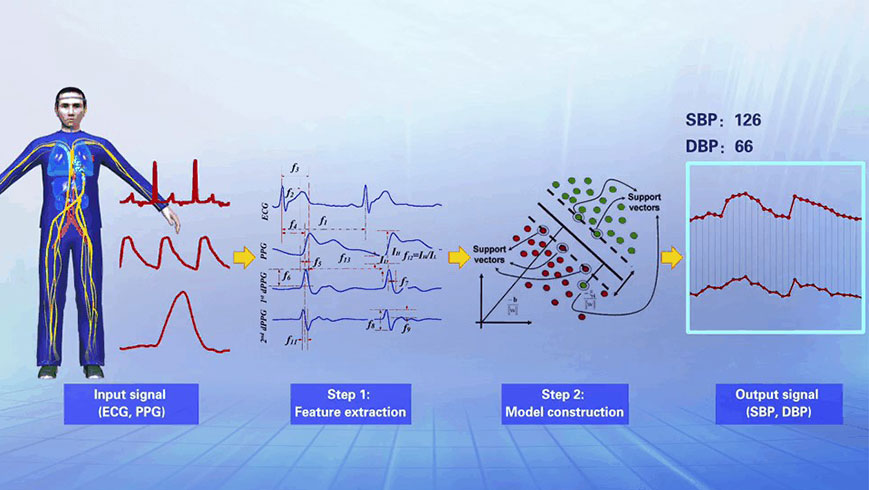 |
Hypertension is one of the most important predictors of cardiovascular disease. Ambulatory blood pressure and its variability (BPV) have been proved to be more reliable predictors of cardiovascular disease. This project intends to study the cuff-less blood pressure measurement method based on wearable devices to realize unobtrusively blood pressure monitoring. Specifically, based on the physiological signals that can be collected by wearable devices, the key indicator for blood pressure fluctuation are explored through data mining techniques, and blood pressure model is established based on multi-instance deep learning; furthermore, the universality and accuracy of blood pressure model are improved by combining mechanism method. At the same time, aiming at the low accuracy of the existing non-invasive blood pressure monitoring methods in specific populations (such as arrhythmic population), the continuous blood pressure waveform monitoring approach is studied based on Gauss decomposition and multi-task deep learning techniques. |
Individual-based epidemic modeling at a city scale with multi-source trajectory data
|
Infectious Disease remains a serious threat to the world. Taking advantage of large-scale trajectory data in which there are embedded individual spatiotemporal activity patterns as well as their pattern fusion with multi-source data, this proposed project models individual mobility with demographics and transmission networks for populous metropolitan areas where there are complex transmission places. This project then establishes a spread simulation model for certain widespread infectious diseases, and validates the proposed modelling methods. |
 |
Large-scale meteorological data processing and a multi-model weather forecast system:
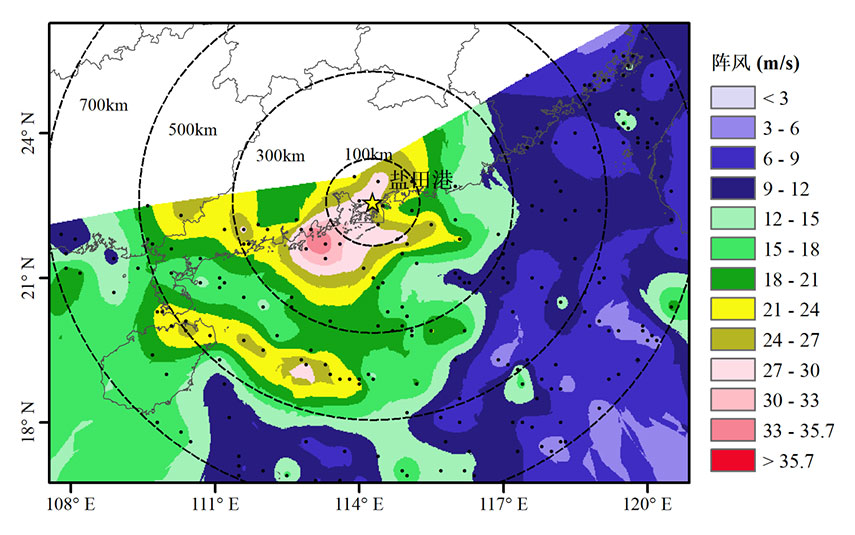 |
We have provided real-time meteorological data assimilation technique, big data analysis, and a multi-model weather forecast system for Shenzhen Meteorological Bureau in the impending severe weather forecast. The module of typhoon wind and rainfall impact estimation has been incorporated into the integrated service platform of Tropical Cyclone, and has been frequently used in the meteorological information bulletin and the industrial weather consultation. |
Spatio-temporal Big Data analytic technology for state estimation of city power system
| Data from multi-resources is collected based on Internet-of-things technology and wearable interacted devices in modern city power system. With Big data platform, multimode and heterogeneous big power data can be managed, data value can be revealed, and spatio-temporal characteristics can be analyzed. Several key technologies are researched, such as stream data management, multi-mode data expression, multiscale data fusion, graphic analysis of large scale power grid, affected region analysis, and correlation analysis. Under this project, breakthroughs have been done using the Big Data analytical engine, for example, power system equipment fault diagnosis can be achieved on-line using Deep Learning method, a large scale of grid topology can be generated with a short time period, risks analysis and power flow computation can be done quickly with parallel computing. By the above-mentioned technologies, the urgent problem of real-time power grid risk evaluation using Big power data has been solved, therefore, the efficiency of power system risk management as well as the safety of the entire city power grid has been greatly improved. | 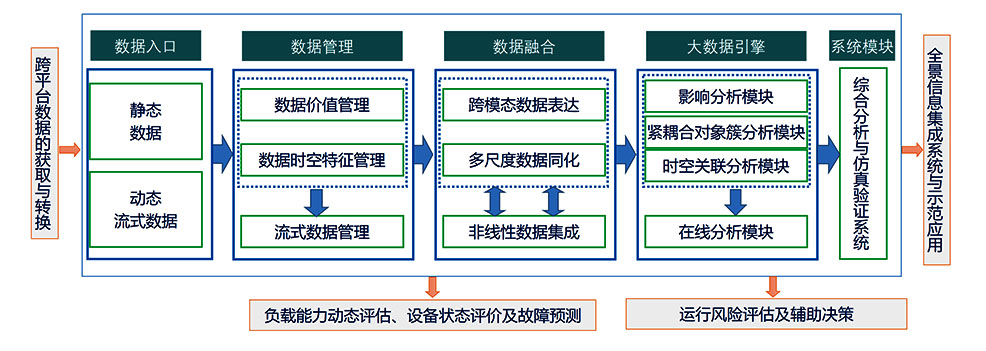
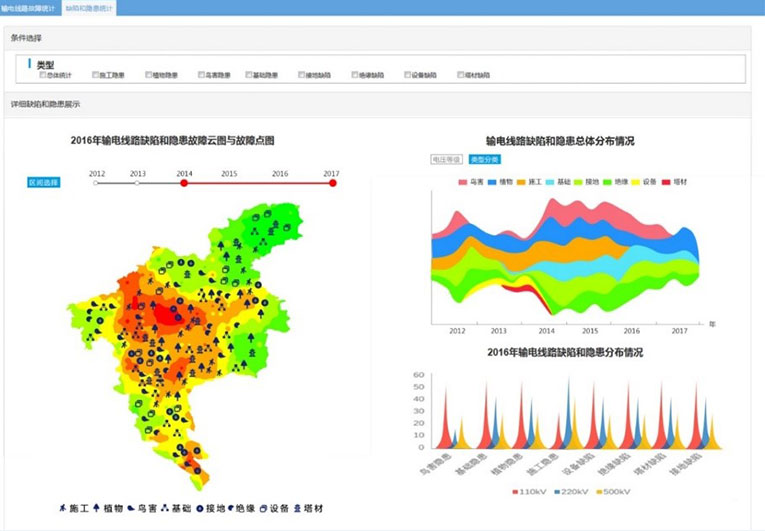
|
